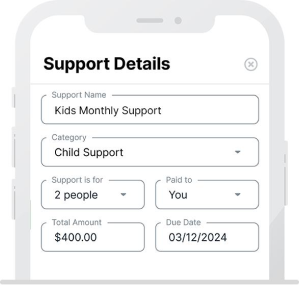The Financial Struggles You Don’t See on a Pay Stub
Employers have long understood that stress affects productivity. That’s why so many HR programs now include wellness apps, mental health support, and even financial literacy tools.
But there’s a deeper issue that remains widely overlooked—one that quietly chips away at employee focus, morale, and retention.
It’s not just how employees budget their money.
It’s how they manage it across households, relationships, and legal obligations.
Welcome to the overlooked reality behind employee financial stress—and the next frontier of workplace wellness.
It’s Not About Overspending. It’s About Overwhelm.
We often assume financial stress is the result of poor planning or lack of knowledge.
But for today’s employees, the real stress comes from complex financial entanglements, such as:
Coordinating child expenses with an ex-partner
Managing eldercare costs with siblings
Paying or receiving child or spousal support
Splitting housing costs with roommates or extended family
Covering unexpected expenses tied to custody schedules or court orders
These aren’t abstract concerns. They’re real-life, recurring stressors that standard financial wellness tools simply don’t address.
What Employers Are Missing
Despite good intentions, many financial wellness programs miss the mark.
They provide:
Budgeting tools
Retirement calculators
General advice on saving
But what they don’t provide is a way to manage shared financial responsibilities across households, the very situation that creates the most friction.
According to SupportPay’s internal research:
90% of employees experience ongoing family financial conflict
83% save time when using a structured coordination platform
94% report improved family relationships when money is managed clearly
That’s not because they learned how to save $20 a week.
It’s because they stopped having the same draining arguments about money over and over again.
The True Cost of Ignoring Financial Coordination
When employers ignore the reality of family financial stress, the costs are both emotional and measurable:
1. Productivity Loss
Every minute an employee spends negotiating a shared bill, chasing a payment, or dealing with financial tension is a minute of lost focus.
And it adds up. Users of SupportPay report saving 11–16 hours per week by automating expense sharing and documentation.
2. Absenteeism and Burnout
Employees under financial duress are more likely to call out, disengage, or experience burnout.
Stress from money fights doesn’t stay at home—it comes to work.
SupportPay helps reduce this by providing clarity, structure, and peace of mind.
3. Retention and Loyalty Risk
Employees want to feel supported beyond the paycheck.
Failing to acknowledge the real financial lives of your workforce can drive disengagement—and ultimately, turnover.
Companies that support family financial coordination show they understand the human side of employee well-being.
Financial Coordination Is the Missing Piece of Wellness
Let’s be clear: budgeting apps have their place. But they’re individual tools for a collective problem.
Most financial stress isn’t about what one person does. It’s about how multiple people manage shared financial responsibility.
That’s why SupportPay is pioneering the Modern Family Finances category—a new kind of financial wellness that:
Automates shared expenses across households
Tracks certified payments for legal, tax, and custody use
Integrates custody calendars and support schedules
Enables credit boosting through verified transactions
Offers secure, structured communication about money
It’s not just another finance app. It’s a system that turns confusion into clarity.
A Human-Centered Tool for a Human Problem
Imagine this: an employee is in the middle of a big project when they receive a text from a co-parent demanding reimbursement for last week’s childcare.
Without a tool like SupportPay, this triggers:
Stress and distraction
Fear of forgetting something important
An emotional spiral that derails focus for the rest of the day
Now imagine that same situation—with SupportPay:
The expense was logged and split automatically
A certified record of payment already exists
Notifications are handled by the platform
No text. No fight. No stress.
That’s the kind of workplace support that actually makes a difference.
The ROI Employers Can’t Ignore
SupportPay delivers outcomes that traditional financial wellness programs can’t touch:
25%+ utilization in year one (vs. 3–5% for standard programs)
$15M+ in productivity gains for mid-sized companies
94 NPS score—proof of user satisfaction and impact
And with no IT lift and instant implementation, it’s one of the fastest, easiest benefits to roll out—with one of the highest returns.
It’s Time to Rethink Financial Wellness
If you’re an HR leader, benefits strategist, or executive decision-maker, here’s what to ask:
Are we truly addressing the root of our employees’ financial stress?
Are we offering solutions for family-based financial coordination?
Do our wellness programs reflect the complexity of modern life?
SupportPay doesn’t replace your current tools. It completes them. It brings a human lens to money—acknowledging that employees don’t just manage their finances alone.
They manage them with family, through conflict, across households, and often, under stress.
Let’s End the Silence Around Shared Financial Stress
Employee financial stress doesn’t start and end with budgeting.
It lives in shared custody calendars.
In sibling group chats.
In the anxiety of one more unexpected payment request.
SupportPay gives employees structure where there used to be chaos—and gives employers a way to support what really matters.
Because when you help your team stop fighting about money, they can start focusing on what they do best: great work.
Ready to help your employees go from stress to structure? Explore how SupportPay can transform your benefits strategy.









